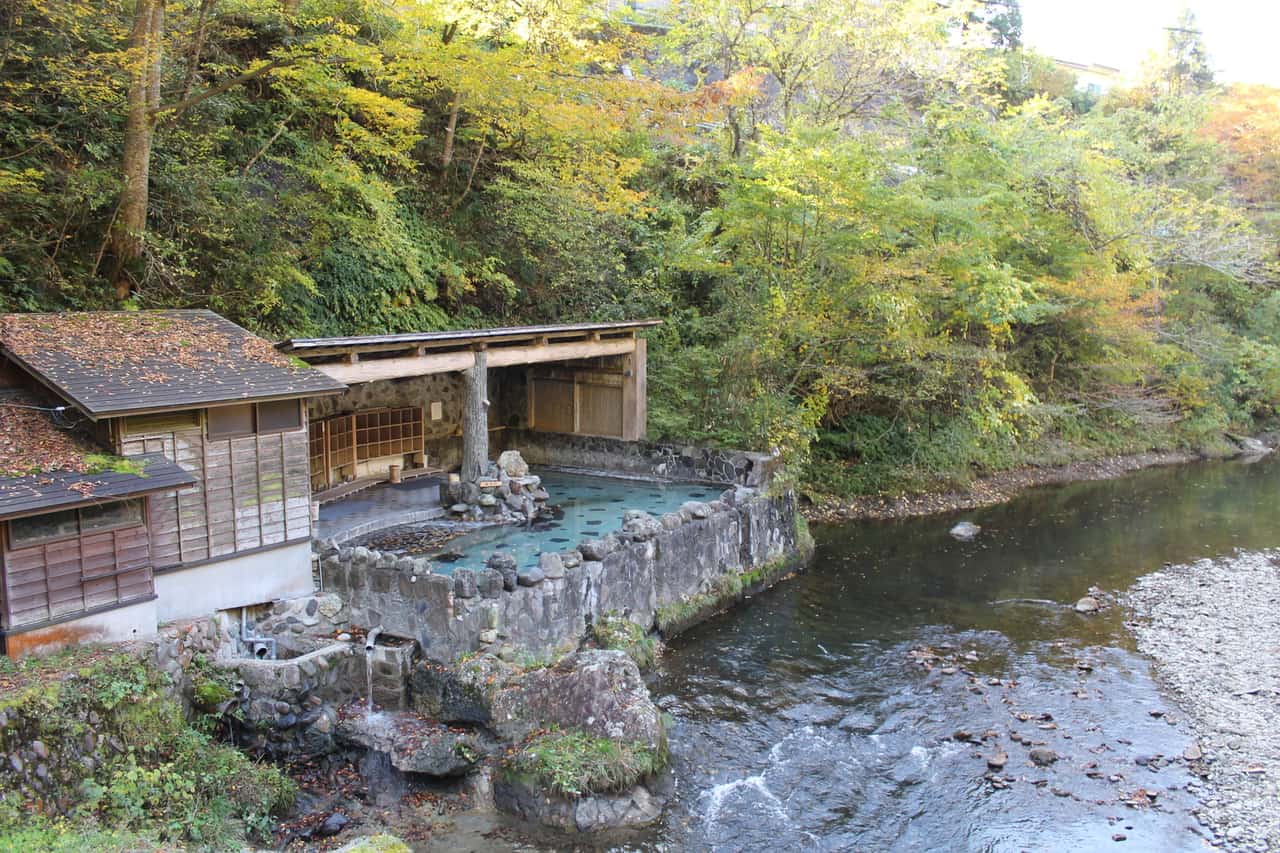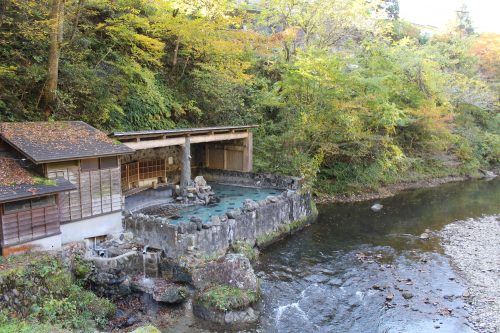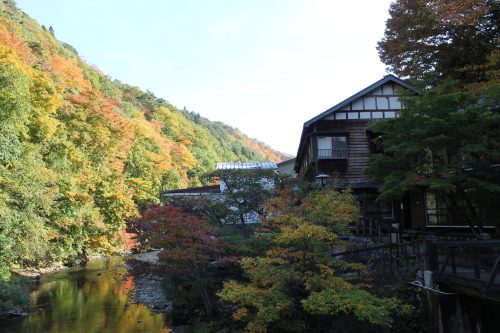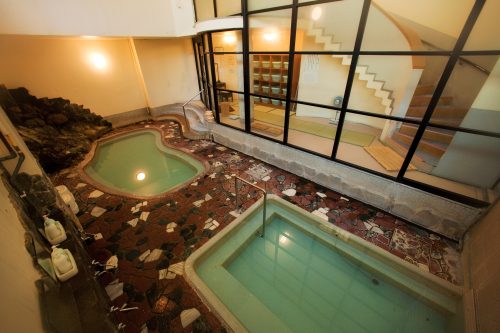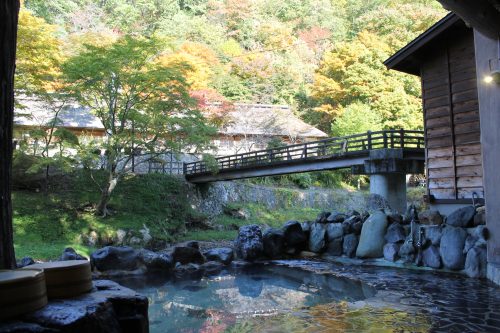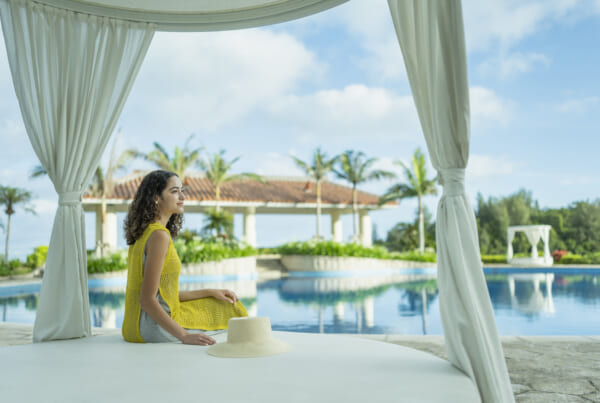Sponsored by Reconstruction Agency
If you travel through Japan, you often experience moments in which you are seeing such beautiful scenery in front of you that you think you have stumbled into an animated film. And this is the feeling that threatens to overwhelm me when I visit Osawa Onsen in Hanamaki, Iwate Prefecture, which is a place where one can climb into the outdoor hot spring and almost touch the crystal clear water of the river, which flows directly past the onsen.
The Osawa Onsen is nestled between quiet slopes. Especially during the autumn season, the landscape offers the guests a breathtaking view that borders on surreal in all its flawless natural beauty. With an azure blue sky, the colorful autumn colors are reflected in the crystal-clear river water as if it were dyed in the most beautiful hues of crimson, green and gold.
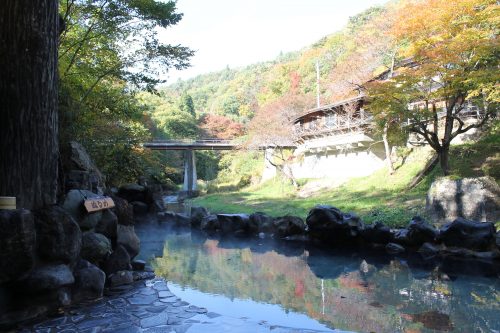
The onsen offers a stunning view at the autumn colours in all their glory.
The Osawa Onsen through the centuries
The wooden buildings of the ryokan are extensive and invite you to discover them more. The oldest parts of the architecture are over 200 years old. The hot springs itself has existed for several centuries and is still frequented by guests from near and far. In Iwate Prefecture, Osawa Onsen is a real gem worth visiting.
Legend has it that once upon a time, a white monkey was spotted washing its wounds in the hot spring water. Since then, people have come to Osawa Onsen to bathe in the hot water and heal both physically and mentally. Old onsens in particular often have a shrine nearby. The Osawa Onsen is no exception. The shrine here is dedicated to a Buddhist god of healing.
Visiting the Old Onsen
The Osawa Onsen Sansuikaku has several baths, some above ground with a view of the river and the surrounding mountain slopes, others are located underground and thus lie below the river water level. The baths change after certain times. For example, one pool is a woman’s bath from about 5 o’clock in the morning until 3 o’clock in the afternoon. After 3 o’clock it changes and only men are allowed.
As in any onsen I have to be completely naked in Osawa Onsen to get into the water. Osawa Onsen provides baskets in which I can store their clothes. There are shower heads, shampoo and body soap provided that allow me to thoroughly cleanse myself before getting into the hot spring.
The underground springs are even more traditional. Here, I have to pour tubs of fresh hot water over my body over and over to wash myself. After that I can enter into the steamy bath, which smells slightly of sulfur and enhances the impression of being in a natural, healing hot spring.
The pools are gender-separated. However, the outdoor pool overlooking the river is the exception. Here, women and men can still bathe together and chat with each other.
Staying in a Ryokan in Hanamaki
Osawa Onsen Sansuikaku is more than just a hot spring. With its many baths and rooms, the onsen seems more like a sanctuary to which people can retreat. Many guests stay for weeks and months to bathe regularly in the healing waters and to enjoy the beautiful nature and clean air.
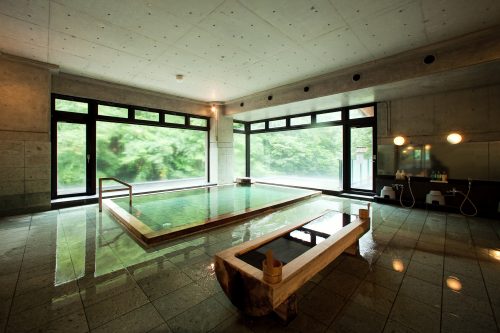
The pools have a wonderful view at nature outside.
The accommodation in Osawa Onsen is relatively cheap. For example, a night in the traditional rooms designed with tatami mats costs between 1500 to 3.700 yen (around 12 to 30 euros). However, things like the futon bed have to be rented. However, the onsen’s focus is not to provide luxurious accommodation, but on purifying and healing the body and mind in nature with pure air and hot spring water.
A stay at the onsen and ryokan must be booked in advance. The baths are open to all; only the family bath must be reserved in advance.
Visiting Namari Onsen and Fujisan Ryokan
My visit to the Namari Onsen Fujisan Ryokan is wonderful as it is fascinating. Namari Onsen is also located in the city of Hanamaki. Surrounded by peaceful nature and a beautiful landscape, Namari Onsen is nestled near a river and offers the perfect setting to relax. The naturally hot water of the hot baths comes directly from the spring, feeding indoor pools as well as an outdoor pool.
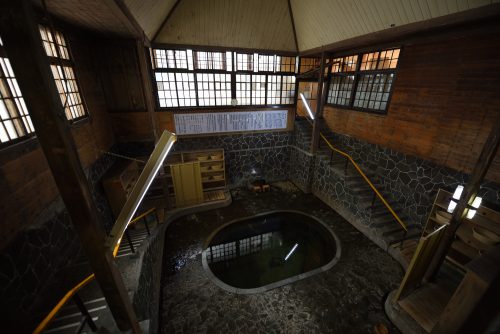
The indoor springs offer a traditional ambiance to relax in.
Guests can take their soothing baths and relax at the sight of the beautiful and wild surroundings. I can literally feel all the tension in my body dissipating as I sit in one of the indoor springs, looking out at the woods that glow in the famous autumn colors.
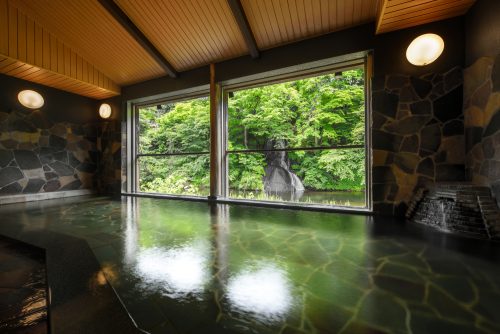
The pools offer guests a stunning view at the surrounding nature.
The ryokan also offers its guests traditional Japanese cuisine, which guests can enjoy either in their rooms or in the dining room. It also offers guest rooms with tatami floors and traditional futon bedding. From all rooms visitors have a wonderful view at the natural environment.
Access, opening hours and prices
Osawa Onsen Sansuikaku is a 30-minute bus ride from Shin-Namari Onsen to JR Hanamaki Station. It takes a one-minute walk from the Osawa Onsen bus stop to the entrance of Osawa Onsen Sansuikaku. The entry fee to the onsen is 1,000 yen.
The Namari Onsen Fujisan Ryokan can also be reached by bus from JR Hanamaki Station. Visitors can take a bus towards Shin-Namari Onsen. From Shin-Namari Onsen bus stop it takes about three minutes on foot to reach Namari Onsen Fujisan Ryokan.
The Official Link: Japan Tohoku New Toji Style
[cft format=0]

